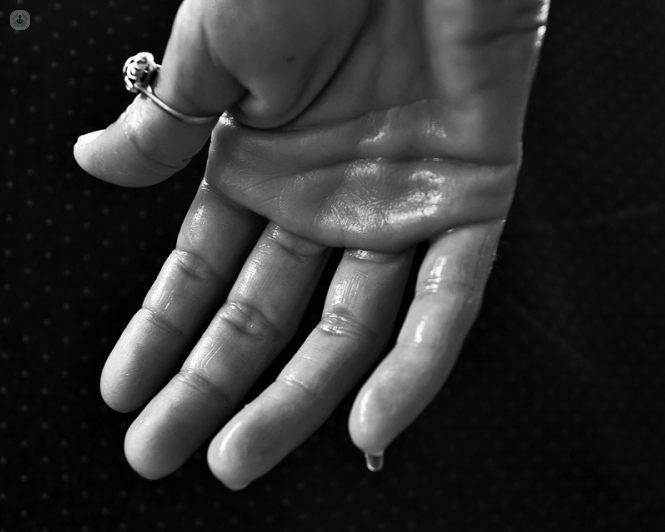ETS surgery: a solution for hyperhidrosis and blushing
Written by:Hyperhidrosis affects a relatively small amount of people in the UK, however, its negative impact on mental health and day-to-day life can be severe.
We spoke with leading vascular and venous surgeon, Mr David Greenstein, who has extensive experience in ETS surgery, to find out how this procedure works as a solution to excessive sweating and blushing.


What is ETS surgery?
Endoscopic thoracic sympathectomy is used as treatment for excessive sweating (hyperhidrosis) and facial flushing.
An ETS involves cutting these sympathetic nerves. The sympathetic nerves that control the sweat glands of the hand and armpits, as well as blushing, runs inside the rib cage near the top of the chest. This surgery is achieved using surgical telescopes and cameras which allows for it to be a keyhole procedure.
Is the ETS surgery the same for sweating as it is for blushing?
In ETS surgery, the nerve is clipped, clamped or cut. This depends on the nerve you’re operating on. I usually cut, but clamping is also an option. Each ETS surgery is quite similar, but you have to have a lot of experience at operating to be good at it. Some surgeons only carry out a handful of ETS surgeries each year, whereas I perform approximately 50.
What is hyperhidrosis?
Simply put, it is excessive sweating. Palmar hyperhidrosis would be in the hands, whereas excessive armpit sweating would be axillary hyperhidrosis. There is also facial hyperhidrosis and hyperhidrosis of the back or feet. The areas you sweat excessively in can determine the type of hyperhidrosis you have.
Which part of the body controls sweating and facial blushing?
In the brain, there is a thermostat, which is different for each patient. If you sweat a lot in your hands, your thermostat could be higher than what is typically common.
This 'thermostat' is in the gland called the hypothalamus. The temperature your body feels comfortable with would be called ‘thermoneutral’. If your brain thinks you’re too hot, it will make you sweat. Hyperhidrosis is an overactivity of the hypothalamic thermoregulatory centre in the brain.
If you feel cold, you’ll do things without realising such as putting on a jumper or jacket. If you're hot, you may open the window. When you do things without even knowing, that’s your hypothalamus. It's part of the autonomic nervous system. Half of your body is controlled through this part, including temperature regulation. The other part of your brain is in control of carrying out tasks consciously, such as eating, cooking, shaking hands or kicking a ball.
If I asked you to speed up your heart rate, you'd have to go for a run, whereas sweating and blushing is a task carried out by the autonomic nervous system.
Are there any other symptoms of hyperhidrosis?
Usually nothing, but there may be an underlying condition causing it such as a tumour.
How much sweating is normal and what is the ‘normal’ amount for someone to blush?
It mostly depends on your personal case and what you feel comfortable with. People who blush may be confident if it wasn't for situations such as blushing excessively during holding presentations or meeting people. Most people know the circumstances where they’re going to blush. Some people spontaneously blush and others know what causes their blushing. A lot of patients have tried counselling, drugs, and many of them have come on a journey having tried different things.
Some people in sales who have facial sweating often find that people think there's something wrong with them. The majority of people I see are for facial blushing, and are people have tried cognitive behavioural therapy and psychological therapy. Some younger patients are peaking in their early 20s, and they're worried about careers, jobs or worried about promotions. Some people have downgraded jobs because they didn’t want to face people; some people have gone more internet related, for example.
Blushing can affect people in many different ways and it usually affects patients for many years. They typically know what treatment options are available when they come to see me and have already decided they definitely want the operation. 90% of patients suffering from blushing that come to see me know everything I'm about to tell them about the procedure as they have already done their own research.
What triggers hyperhidrosis or blushing?
Facial blushing is normally triggered by a social situation or work. When there's an engagement with someone, sweating can also occur without doing anything. Stress can also make you sweat or blush. Some people who excessively sweat can be relaxed and still be sweating. It is related to the outside temperature.
What other ways can these conditions be treated?
Like with any treatment, you need to get proper advice. Sometimes with a GP, they know nothing about blushing, and the important thing is that there are treatment options. Many choose to live with it; some try going for counselling or try hypnotherapy to lower anxiety; each person has a different journey, often resulting in keyhole surgery.
With excessive sweating, some choose to live with it, and others change habits, use antiperspirants or drug therapy. Other non-surgical options include iontophoresis for sweating. It’s a combination of lifestyle changes, coping, non-surgical treatments, iontophoresis for certain parts of the body or surgery. Mira dry is something you can do for armpits but it's not licensed for the back and chest.
If you check out my website, www.eblushing.com, you can find the range of treatment options that I offer.
For more guidance, you can book an appointment with Mr David Greenstein via his Top Doctors profile.


